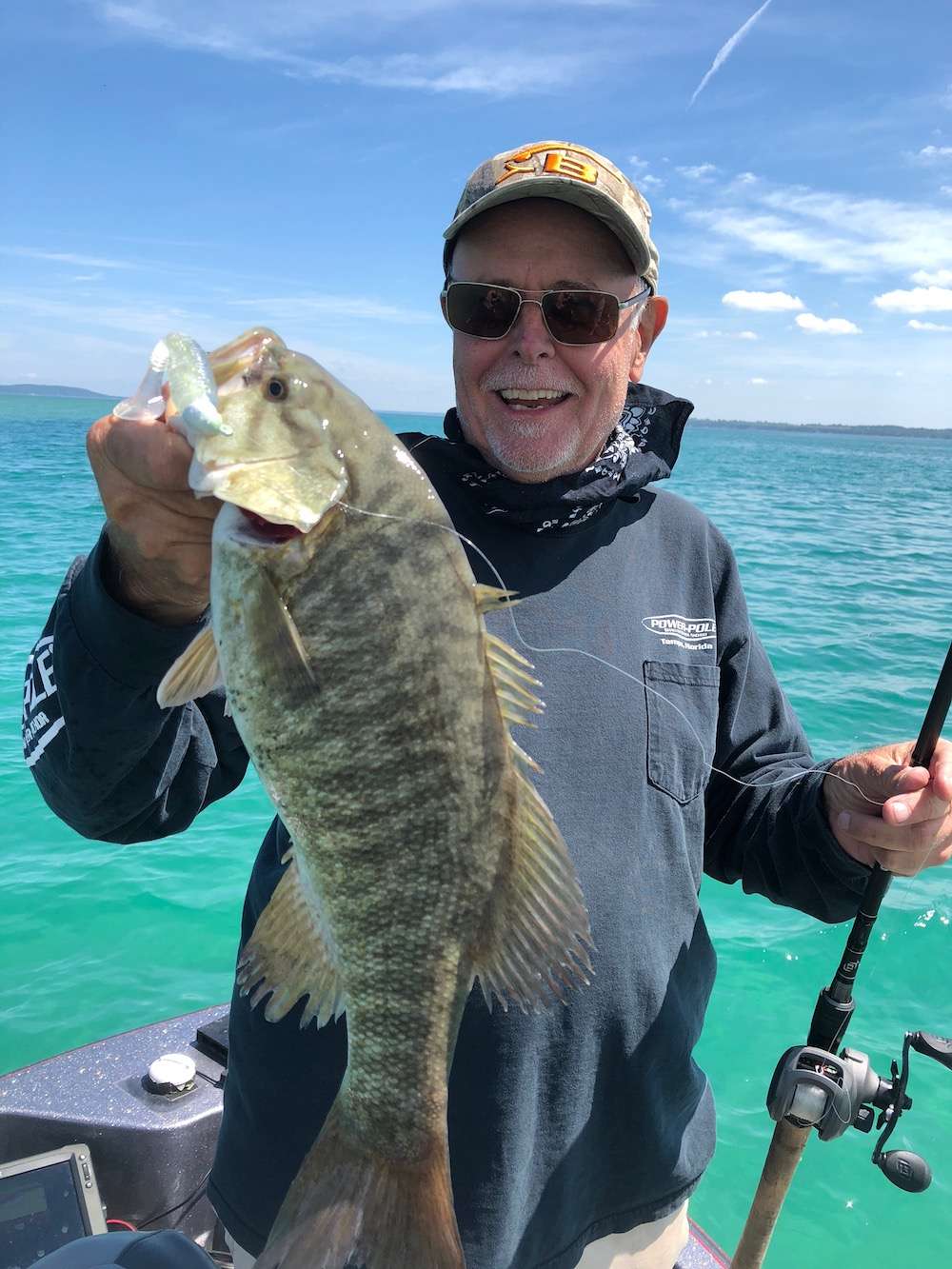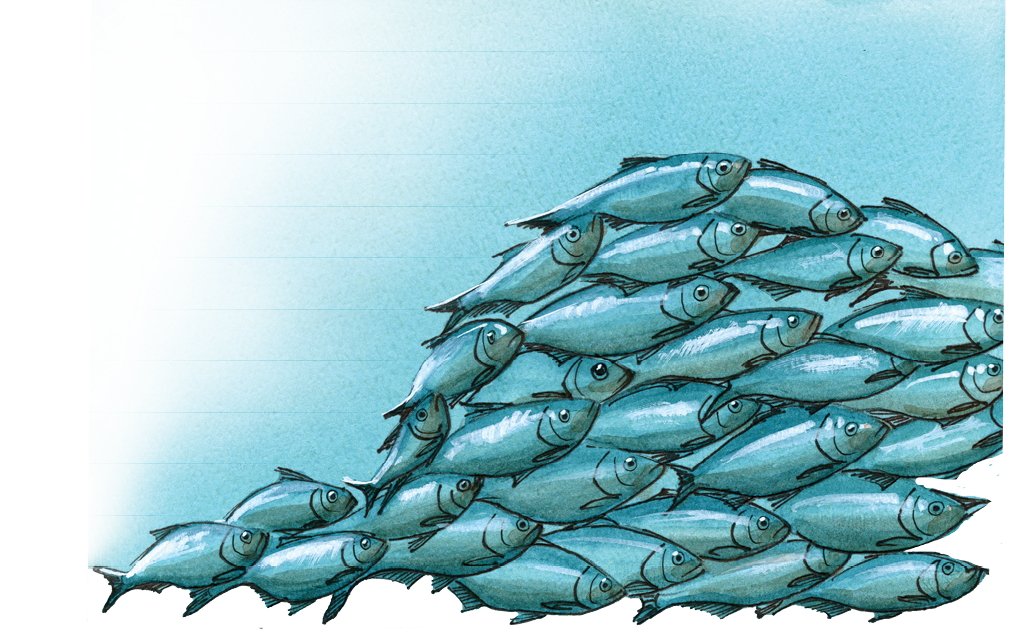
When you’re not catching bass around cover or structure, it’s easy to believe the fish must be there, but they just aren’t biting. After all, Bass Fishing 101 taught us that bass, first and foremost, are an object- and structure-related fish. Nearly every bass fishing article and TV show we see reminds us that bass either 1) hang close to submerged brushpiles, stumps and weedbeds in shallow water; or 2) prowl points, humps, ledges and creek channel dropoffs out on the main lake. What bass don’t do is cruise open water and wander great distances offshore like walleye, stripers or bluefin tuna.
Or so you thought!
The fact is, sometimes bass relate more strongly to wandering baitfish schools than anything else in their environment. They’ll bird-dog schools of threadfin shad, alewives or other offshore bait species around the lake, sometimes miles from shore. When this happens, factors such as cover, bottom contours, even depth, become irrelevant — these fish are focused on their food source, and little else. When they’re in this mode, they can be extremely difficult to locate and catch. Difficult, but not impossible.
Bassmaster sought input on this strange bass pattern from three experts. What they’re about to reveal will shed light on one of bass fishing’s most perplexing puzzles: How to locate and catch bass when baitfish become structure.
COOK’S QUOTES
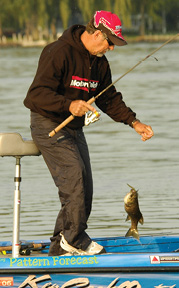 Ken Cook is a student of bass behavior from both the academic and practical perspective. The legendary pro angler, now retired, holds a degree in zoology from Oklahoma State University and worked as a fisheries biologist for his home state for 13 years before joining the B.A.S.S. trail in 1980. Applying his scientific background to the hardcore world of competitive angling helped Cook become a tournament star. During his 29-year career, he won six B.A.S.S. events, qualified for 14 Classics and won the 1991 Classic on the Chesapeake Bay. His background makes him uniquely qualified to address the phenomenon of offshore bass relating to baitfish schools.
Ken Cook is a student of bass behavior from both the academic and practical perspective. The legendary pro angler, now retired, holds a degree in zoology from Oklahoma State University and worked as a fisheries biologist for his home state for 13 years before joining the B.A.S.S. trail in 1980. Applying his scientific background to the hardcore world of competitive angling helped Cook become a tournament star. During his 29-year career, he won six B.A.S.S. events, qualified for 14 Classics and won the 1991 Classic on the Chesapeake Bay. His background makes him uniquely qualified to address the phenomenon of offshore bass relating to baitfish schools.
“This phenomenon usually occurs in late summer, after young-of-year shad have grouped up enough to form large schools,” Cook says. “Threadfin shad are pelagic, meaning they inhabit open water, and are not shoreline-related like bass usually are. They eat phytoplankton, which are microscopic plants free-floating in the water. Wind and current cause phytoplankton concentrations or ‘blooms’ to drift offshore, the baitfish follow the phytoplankton blooms, and predators, including bass, follow the baitfish. It’s a classic food chain scenario.”
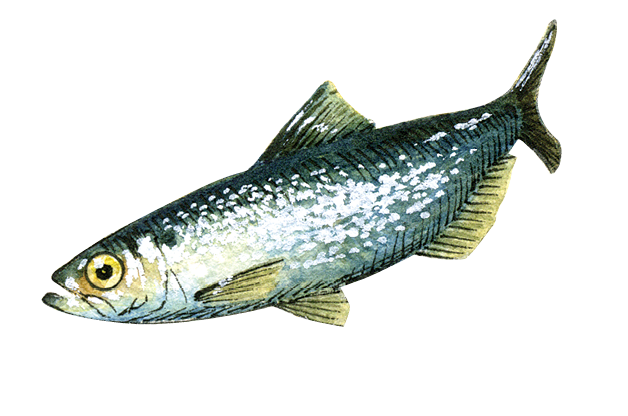 Cook occasionally attempted to cash in on this offshore pattern during his tournament career. “During a B.A.S.S. event on Oneida Lake, New York, I was tipped off to a school of offshore bass during practice when I noticed flocks of birds circling overhead as I was crossing the lake,” he says. “My graph revealed a massive school of baitfish, probably emerald shiners, suspending in the upper portion of the water column with hooks and streaks indicating bass all around them. I caught one smallmouth after another by jigging a spoon around the baitfish school.” But on the first day of competition, Cook’s offshore bass were nowhere to be found. “That’s the danger of putting your chips on this pattern in a tournament: When the baitfish move, the bass will follow.”
Cook occasionally attempted to cash in on this offshore pattern during his tournament career. “During a B.A.S.S. event on Oneida Lake, New York, I was tipped off to a school of offshore bass during practice when I noticed flocks of birds circling overhead as I was crossing the lake,” he says. “My graph revealed a massive school of baitfish, probably emerald shiners, suspending in the upper portion of the water column with hooks and streaks indicating bass all around them. I caught one smallmouth after another by jigging a spoon around the baitfish school.” But on the first day of competition, Cook’s offshore bass were nowhere to be found. “That’s the danger of putting your chips on this pattern in a tournament: When the baitfish move, the bass will follow.”
How deep this pattern occurs depends largely on light penetration, Cook has found. “In clear lakes, bass may target offshore baitfish schools at depths of 50 feet or more in summer and early fall. In highly fertile lakes with stained water, they’ll be much shallower — 15 feet is a good rule of thumb,” Cook says. “It’s easy enough to determine how deep the bass are — just idle around offshore and note the depth of the baitfish schools and bass hooks on your graph.”
NOFFSINGER’S NOTES
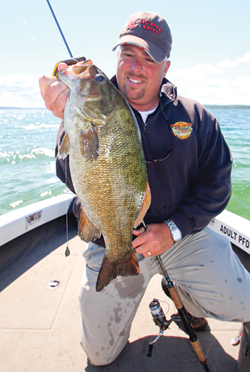 Interlochen, Mich., smallmouth guide and Bass Pro Shops Bassmaster Northern Opens competitor Chris Noffsinger is intimately familiar with the offshore bass/baitfish scenario. “Every summer, I book guide trips on Lake Michigan with guys who are used to casting spinnerbaits around stump flats on their home lakes, and it blows their minds when I run 10 miles offshore to a school of smallmouth suspending 65 feet deep in 200 feet of water,” he says, laughing. “These fish are out there for only one reason: to gorge on alewives. Cover doesn’t come into play at all, and the only ‘structure’ the bass are relating to is the baitfish school itself.”
Interlochen, Mich., smallmouth guide and Bass Pro Shops Bassmaster Northern Opens competitor Chris Noffsinger is intimately familiar with the offshore bass/baitfish scenario. “Every summer, I book guide trips on Lake Michigan with guys who are used to casting spinnerbaits around stump flats on their home lakes, and it blows their minds when I run 10 miles offshore to a school of smallmouth suspending 65 feet deep in 200 feet of water,” he says, laughing. “These fish are out there for only one reason: to gorge on alewives. Cover doesn’t come into play at all, and the only ‘structure’ the bass are relating to is the baitfish school itself.”
Noffsinger says this pattern becomes increasingly prevalent in the Great Lakes region as the water warms from the low 60s to the mid-70s, following the June or early July smallmouth spawn. “After spawning, bass are ready to put on the feed bag and will follow baitfish schools offshore. I’ve caught big smallies 70 feet deep on this offshore pattern in Grand Traverse Bay on Lake Michigan. This phenomenon also occurs during summer on deep glacial lakes in our area; here, it’s common to find bass offshore in the 40-foot zone.”
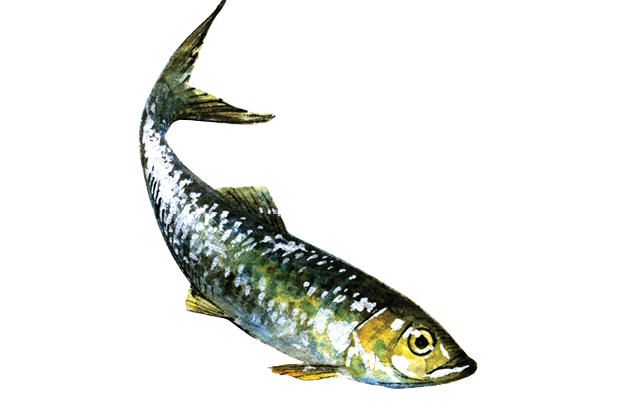 Noffsinger locates offshore bass by watching for “slick spots” on the water’s surface and flocks of birds circling overhead. “A slick spot can be a tip-off of a temperature change or current break, both of which will concentrate plankton and attract vast quantities of baitfish. The birds are feeding on dead or injured baitfish on and just below the surface.”
Noffsinger locates offshore bass by watching for “slick spots” on the water’s surface and flocks of birds circling overhead. “A slick spot can be a tip-off of a temperature change or current break, both of which will concentrate plankton and attract vast quantities of baitfish. The birds are feeding on dead or injured baitfish on and just below the surface.”
The Michigan angler has found this offshore pattern produces mixed results in tournament competition. “In most bass fishing situations, you have a general idea of what cover or structure bass will be using depending on the season, but when you take cover and structure out of the equation, all you’ve got left is their food source,” he points out. “And when that food source is constantly moving, it can make it hard to stay with your fish. During the 2009 Northern Open tournament on Lake Erie, I located smallmouth in deep water offshore during practice and managed to [stay] with them as they followed baitfish shallower once competition began. But at the 2010 event on the Detroit River, the huge school of suspended smallies I had found during practice evaporated by the time the tournament started when their food source moved.”
LOWEN’S LOGIC
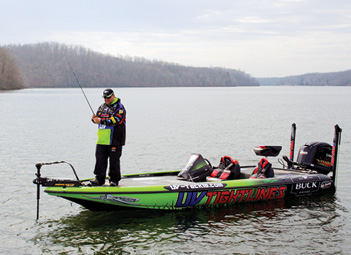 Elite Series pro Bill Lowen of Ohio also finds targeting offshore bass to be challenging. “This is something I don’t relish doing in a tournament unless I absolutely have to because it’s way outside my comfort zone — I’m primarily a shallow-water fisherman,” he admits. “Still, I’ll target offshore fish if that’s what it takes to be competitive, because if you can stay with them, you can load the boat in a hurry when your timing is right. I’ve done this recently on lakes Murray [South Carolina] and Clarks Hill [Georgia], where bass were preying on big schools of blueback herring offshore.”
Elite Series pro Bill Lowen of Ohio also finds targeting offshore bass to be challenging. “This is something I don’t relish doing in a tournament unless I absolutely have to because it’s way outside my comfort zone — I’m primarily a shallow-water fisherman,” he admits. “Still, I’ll target offshore fish if that’s what it takes to be competitive, because if you can stay with them, you can load the boat in a hurry when your timing is right. I’ve done this recently on lakes Murray [South Carolina] and Clarks Hill [Georgia], where bass were preying on big schools of blueback herring offshore.”
Lowen says a close examination of your graph often reveals offshore bass may be “loosely relating” to something besides a baitfish school. “I often find them suspending between two main-lake points, or over a channel dropoff or submerged roadbed. They may be 100 feet away from the structure, but they’re relating to it nonetheless. In fact, this is a good way to locate these fish: Position your boat at a point of a major tributary, and then idle toward open water. Chances are, a big ball of bait with bass hooks and streaks around it will show up on your graph.”
The likelihood that offshore bass will eventually drive a school of baitfish to the surface prompts Lowen to always keep a topwater lure tied on during summer. “I’m not going to sit off a point all morning waiting for them to surface, but I’ll always watch for offshore bass busting baitfish on top when I’m running from one spot to another. I’ve even seen surfacing bass mixed in with schools of striper and hybrids when they’re on this pattern.”
LURES AND PRESENTATIONS FOR BAITFISH-FOLLOWING BASS
Forget about casting spinnerbaits to shallow cover or dragging bottom with that football jig. We’re talking extremes here: Suspended bass are relating to nothing but baitfish schools in open water. How the heck do you catch these fish? Former Classic champ and fisheries biologist Ken Cook, smallmouth guide and Northern Opens competitor Chris Noffsinger and Elite Series pro Bill Lowen offer some proven recommendations.
-
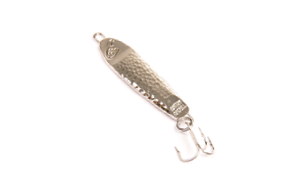 Go vertical — Vertical fishing may be your only option when offshore bass are suspending around baitfish schools in deep water. Metal spoons and blade baits jigged vertically at or just above the depth of bass streaks indicated on your graph can load the boat in a hurry.
Go vertical — Vertical fishing may be your only option when offshore bass are suspending around baitfish schools in deep water. Metal spoons and blade baits jigged vertically at or just above the depth of bass streaks indicated on your graph can load the boat in a hurry. -
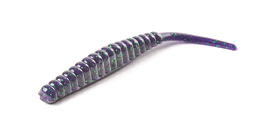 Give it a shot — Drop shot rigs with finesse worms, gobies, leeches and other small artificials will catch offshore bass regardless of how deep they are, provided the baitfish school they’re targeting is fairly close to the bottom.
Give it a shot — Drop shot rigs with finesse worms, gobies, leeches and other small artificials will catch offshore bass regardless of how deep they are, provided the baitfish school they’re targeting is fairly close to the bottom. -
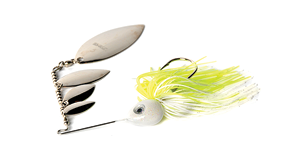 Count ’em down — A 1- to 2-ounce spinnerbait, or a weighted swimbait, can be counted down and slow rolled through a suspended baitfish school to tempt an open-water lunker.
Count ’em down — A 1- to 2-ounce spinnerbait, or a weighted swimbait, can be counted down and slow rolled through a suspended baitfish school to tempt an open-water lunker. -
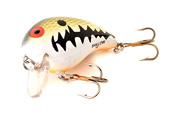 Go to school — Even if you aren’t focusing on offshore bass, keep a topwater lure tied on in summer and early fall in the event you spot surface feeding activity. Choose a lure you can cast a long distance — such as a big walking bait, popper or wake bait — and make sure your reel’s drag will slip under pressure from a big bass.
Go to school — Even if you aren’t focusing on offshore bass, keep a topwater lure tied on in summer and early fall in the event you spot surface feeding activity. Choose a lure you can cast a long distance — such as a big walking bait, popper or wake bait — and make sure your reel’s drag will slip under pressure from a big bass.
To see the entire September/October 2013 issue of Bassmaster Magazine, click here.

